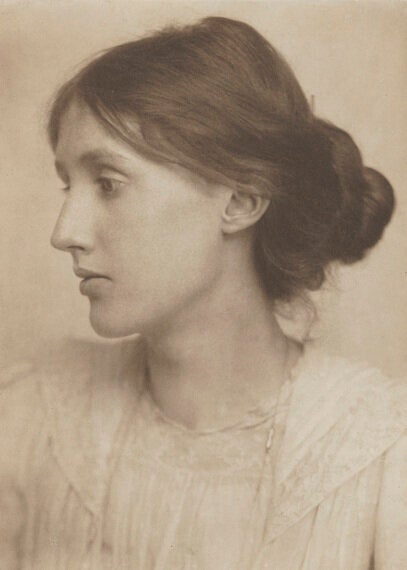

Virginia Woolf: Art, Life and Vision at the National Portrait Gallery is the first exhibition to explore the life and achievements of Virginia Woolf through portraiture.
There are over 140 items on display including paintings, photographs and rare archival material which together, really bring to life both the Bloomsbury Group and Virginia in particular.
The exhibition starts, not with Virginia's birth, but with the destruction of her Tavistock Square house in a German bombing raid in the Second World War.
It's an interesting opening but also a smart one as Virginia was a private woman, having once commentated that "I must be private, secret, as anonymous and submerged as possible in order to write."
But this very public act of destruction of her former house and meeting place for the Bloomsbury Group gives us an opportunity to see inside not just her home, but also understand Virginia's interests.
To know all about Virginia Woolf, of course you have to learn much about the Bloomsbury Group, the influential group of writers, artists, thinkers and philosophers that Virginia and her husband Leonard were key members of.
On show are a number of portraits both of Virginia and of key members of the Group such as Roger Fry and Duncan Grant by other members of the Group, including Vanessa Bell, Virginia's sister.
The intellectual stimulation and inspiration that Virginia took from this group is evidenced in the display not just through the impact that their thought had on her writing, but also in the creation of the Hogarth Press, which Virginia and her husband started to publish works that challenged conventional thought.
An early manuscript of James Joyce's Ulysses is on show, which was offered to the Hogarth Press for publication.
Sadly Virginia and her husband had to decline as their production process was intensively manual and the length of Ulysses was prohibitive but Virginia's comments on the book in a note in the exhibition made me laugh and nod knowingly, describing it as "spasms of wonder, of discovery, and then again... long lapses of intense boredom."
The exhibition looks at how all these external influences impacted Virginia's writing. Virginia responded to living in London on many levels and it led to a phase of enormous productivity where she completed Mrs Dalloway, To The Lighthouse, Orlando, A Room of One's Own, The Waves and Flush all in less than a decade.
And certainly the influence of the Bloomsbury Group and their promotion of democracy, anti-imperialism and anti-warmongering can be found in Virginia's writings as well as in her activism.
Woolf's political awareness was particularly prominent during the Spanish Civil War. In her book Three Guineas, published in 1938, Woolf asks "What can we do to prevent war?", and she supported fundraising events for those affected by the Spanish Civil War. The exhibition includes one of Picasso's Weeping Woman drawings which he created specifically for a fundraising event at the Royal Albert Hall, at which Virginia and Leonard Woolf sat on the platform.
Supporting the paintings and archive materials are also many photographs of Virginia inside 52 Tavistock Square, two floors of which were set aside solely for the Hogarth Press. These include shots taken by such important photographers as Man Ray, and Beck and McGregor who photographed Woolf for Vogue.
Virginia had this very fragile beauty, which made her incredibly photogenic. Her beauty just radiates from these photographs. But she also had a troubled mind and in none of these pictures is she smiling or uplifted.
For casting a shadow over Virginia's life was her battle with mental illness.
It would be impossible for an exhibition about Virginia Woolf to be complete without addressing this but the National Portrait Gallery have handled this beautifully, not letting it weigh the exhibition down but showing how its reoccurrences affected Virginia's work and her marriage, before it overtook her life completely.
Virginia's nephew - Vanessa Bell's son - died in the Spanish Civil War where he had volunteered as an ambulance driver. The loss of her nephew affected Virginia greatly but it was her sister who suffered more, having a complete nervous breakdown.
Virginia nursed her sister back to health but her own health soon suffered. The exhibition has on display some hand-written notes that Virginia wrote to her husband and her sister in the days and weeks before she committed suicide in 1941.
These are incredibly affecting to read - both for Virginia's insight into her own illness, aware that the darkness was falling, and because we know how this sadly ended.
"I am certain now that I am going mad again", she writes. "It is just as it was the first time." And in a second letter she adds "I feel certain that I am going mad again... I can't fight it any longer."
It's an incredibly sad way to end this exhibition but probably the most appropriate ending.
I would recommend this exhibition completely for both fans of Virginia Woolf and those who know very little about her as the combination of photos, portraits and diaries really bring to life the woman and the world in which she lived.
National Portrait Gallery, London to October 26, 2014
Image credits:
1. Virginia Woolf by George Charles Beresford © National Portrait Gallery, London
2. Virginia Woolf by Vanessa Bell c.1912. Copyright: Estate of Vanessa Bell, courtesy Henrietta Garnett. Photo credit: © National Trust / Charles Thomas
3. T.S. Eliot and Virginia Woolf by Lady Ottoline Morrell, June 1924. Copyright: National Portrait Gallery, London
4. Virginia and Leonard Woolf by Gisele Freund, 1939. Copyright: Estate Gisèle Freund / IMEC Images